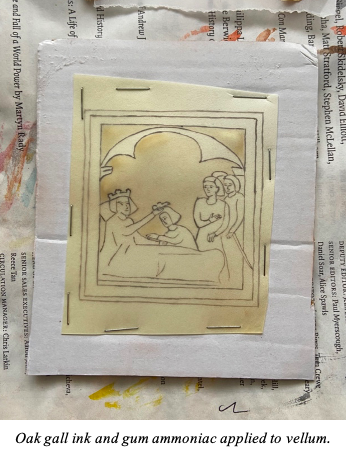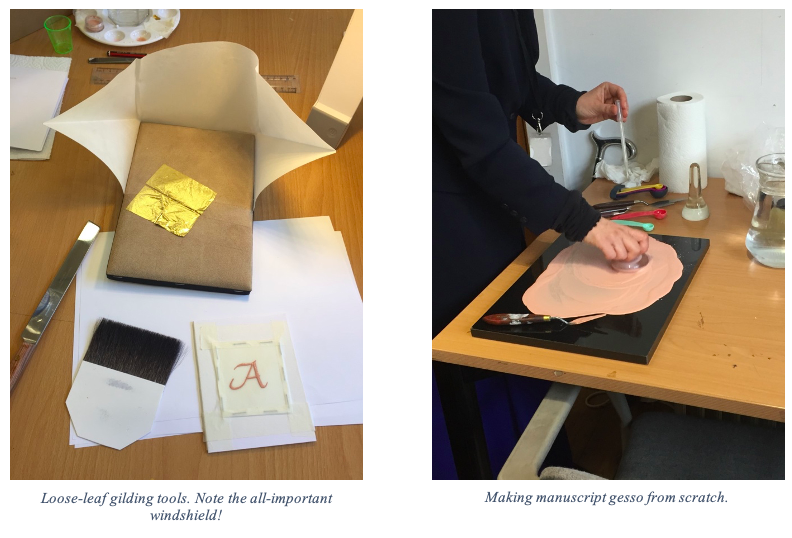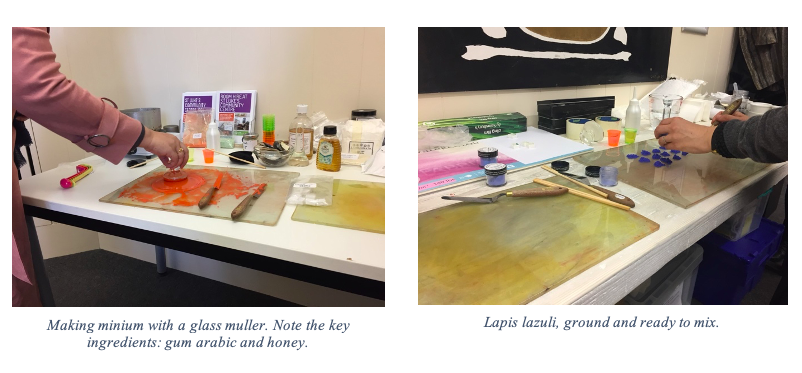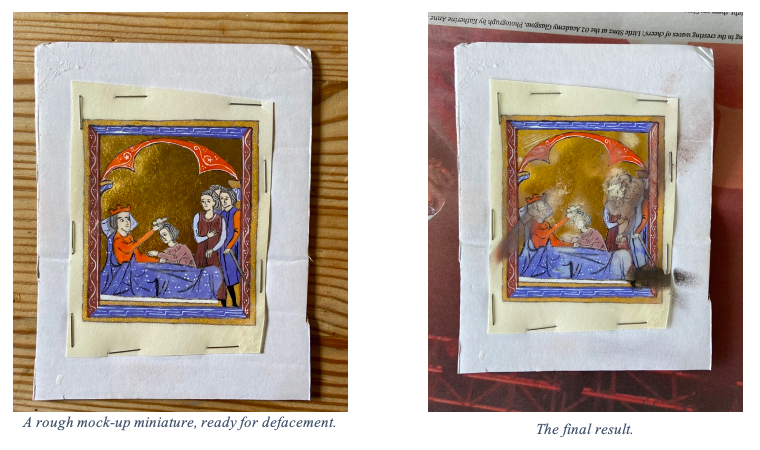What can we learn from practice-led approaches to medieval codicology? Before pursuing my graduate studies in medieval literature, I trained as an illuminator. Over the course of a year, I took practical courses in gilding, pigment-making, and Anglo-Saxon, Celtic, and later medieval styles of illumination at the Prince’s Foundation School of Traditional Arts in London. I now work primarily with gold on vellum, coupled with traditional pigments and foraged inks, to create both reproductions of medieval designs and original pieces. My undergraduate studies had already inspired a keen interest in the medieval material text, and it was always the illuminated manuscripts that would catch my eye, with their ability to capture and manipulate the subtle interactions between light, metal, and parchment. It therefore seemed a natural step to learn more about the practical side of the production and decoration of medieval books. I am now academically trained as a medievalist; working with manuscripts on a regular basis, I thus bridge two seemingly overlapping but still quite distinct fields.
Experiential and artistic knowledge of the processes and materials of illumination is very rarely applied to formal academic study. There have been two wonderful collaborations that use the practices of modern working scribes as tools for historical research: that of Patricia Lovett and Michelle Brown, and of Patrick Conner and Cheryl Jacobsen, both of which focus primarily on palaeography and script.[1] I was recently able to take part in a similar collaboration with postdoctoral researcher, Henry Ravenhall, but in our case, with a focus on gold, ink, and pigment in manuscript miniatures. Henry’s work explores the evidence of tactile interactions between readers and their books, and, in particular, instances in which images have been visibly (and often forcibly) erased. Faced with the obvious problem of not being able to test Henry’s hypotheses on actual medieval manuscripts, we decided to put my illumination training to experimental and destructive use, and create a mock-up miniature to rub out.
I spent some time studying our chosen miniature (on fol.238va of Boulogne, Bibliothèque Municipale, MS 142) to establish how best to create a faithful replica with the materials I had. One of the most useful skills my illumination training has given me is in fact that of observation. Deep experiential familiarity with these materials makes it far easier to recognise and identify what is on a manuscript page; for instance, I could be fairly confident that this miniature used gesso as a mordant underlaying gold leaf, and visually distinctive pigments such as minium (a lead oxide) and lamp black (soot and ash mixed with vegetable oil). Of course, this approach can never be a substitute for pigment analysis, which is the only way to know for sure what you have in front of you, but in cases where analysis proves too expensive, laborious, and even damaging, informed observation can still play a valuable role.

Having established what I would need, I began the process of replicating the miniature. The first step was choosing an appropriate piece of vellum: sufficiently high quality so as not to undulate wildly on contact with paint, but not so precious as to be a terrible waste, given its intended fate. I usually work on a very small scale, so I tend to use vellum offcuts. Here, I chose a firm, thin piece with a smooth flesh side, as the gold would adhere best to this. Having not touched the folio of the manuscript I was replicating, I cannot be sure that this was the most authentic choice, but the quality of illumination on hair vs flesh sides would certainly be a worthwhile topic for future experimental investigations. Next, I transferred the design with a powder pigment, dusted onto the reverse of a thin sheet of paper and pressed firmly onto the vellum with a sharp point (how we did things before the advent of tracing paper). I then set the outline in indelible oak gall ink, made by hand with foraged materials in 2017. It keeps well, and darkens with age. With the oak gall, I hoped to confirm a hypothesis formed when Henry first showed me a selection of rubbed-out manuscript images, in which the pigments had been displaced, but the outlines remained. My assumption, based on the properties of oak gall, was that these outlines had been painted in permanent ink, and the image later exposed to moisture that affected only the coloured pigments.
After the oak gall ink had dried, I began the gilding. This is the stage at which a full appreciation of the time-consuming and laboursome process of medieval illumination really comes to the fore. Medieval mordants—the tacky substances applied to the vellum, to which the gold then adheres—were all made by hand, with gums and resins and plasters and animal-based glues, often toxic, smelly, and unpleasant in equal measure. Some of these can be bought ready-made today, but I find homemade to be easier to work with, as it is possible to control factors such as thickness and viscosity, which in turn have a significant impact on the finish of the gold. For this experiment, I opted for several layers of gum ammoniac (a natural mordant made from dried tree sap, widely used throughout the Middle Ages) in place of the gesso of the original. Gesso is time-consuming, expensive, and complex to produce, and therefore rather too precious for so destructive an experiment!
The mordant must be left to dry; I left an hour or so in between coats, and waited overnight before applying the gold the following morning. For this piece, I used transfer gold leaf, another modern luxury, in place of the flimsy and fragile loose-leaf that I would ordinarily pair with gesso for a mirror-shine finish. Loose-leaf gold blows away at the slightest breath of wind (we can imagine the frustration of a draughty scriptorium back in the day), and is very sensitive to slight changes in temperature and humidity. So, for the sake of efficiency, I opted for transfer leaf, in a beautiful 24 carat.

Once the gold was laid (the excess removed with a squirrel-hair brush), and burnished to a shine with an agate dogtooth burnisher, it was time to go in with the pigments. I kept these as close to the original miniature as it is possible to get from observation alone, choosing a combination of minium (a bright orange), venetian red (a crimson-brown), and lapis lazuli (a dazzling, highly-prized blue). All these pigments were made to medieval recipes on one of my training courses, mixed by hand in a process known as mulling. Finally, I added the outlines, patterns and details in lamp black and Chinese white (a zinc oxide pigment used in place of the highly toxic flake white, in anticipation of how much we would be touching the paint).

The final step was, of course, to rub everything out. See Henry’s previous post [Experimenting with the Touch of Medieval Books. Part 1.] to see what we found!
As historians of the book, it should be our priority and interest to preserve the primarily oral traditions that produced the artefacts we study. Making (and indeed defacing) miniatures is a craft experience as well as an interpretative one, and both of these are valuable. There are increasingly few people now with the relevant knowledge and skills needed make vellum from hides, to produce gilded and illuminated manuscripts, to mix pigments to authentic recipes, or to forage oak galls and cultivate woad. There is no authoritative textbook on these practices, and much of what I have learned has come to me through word of mouth—that a pin-drop of clove oil takes the bubbles out of gesso, or that clam shells really do make the best containers for shell gold (that is, after all, how it got its name). Without continued practical interest in these traditions, illumination risks being lost, along with hundreds of other heritage crafts that have slowly become mechanised over the years. And for manuscript scholars, first-hand knowledge of these processes, and the benefits that that knowledge brings, risk being lost too. In our ever-more digital approach to the teaching and practice of manuscript studies, there is something to be said for hands-on interaction with the raw materials. Experimental codicology can, I think, go some way to making intangible heritage tangible again—to making past reading experiences relatable, re-creatable, and, consequently, preservable.

My thanks to two wonderful teachers, Christabel Anderson and Helen White, for sharing their invaluable wisdom on the properties of gold, pigment, and parchment.
Rebecca Field, PhD Candidate in the Faculty of English, University of Cambridge
[1] Michelle Brown and Patricia Lovett, The Historical Source Book for Scribes (London: British Library, 1999);
Cheryl Jacobsen, ‘A Modern Scribe Views Scribes of the Past’, in Scraped, Stroked, and Bound: Materially Engaged Readings of Medieval Manuscripts, ed. Jonathan Wilcox (Turnhout: Brepols, 2013), pp. 75-92.
